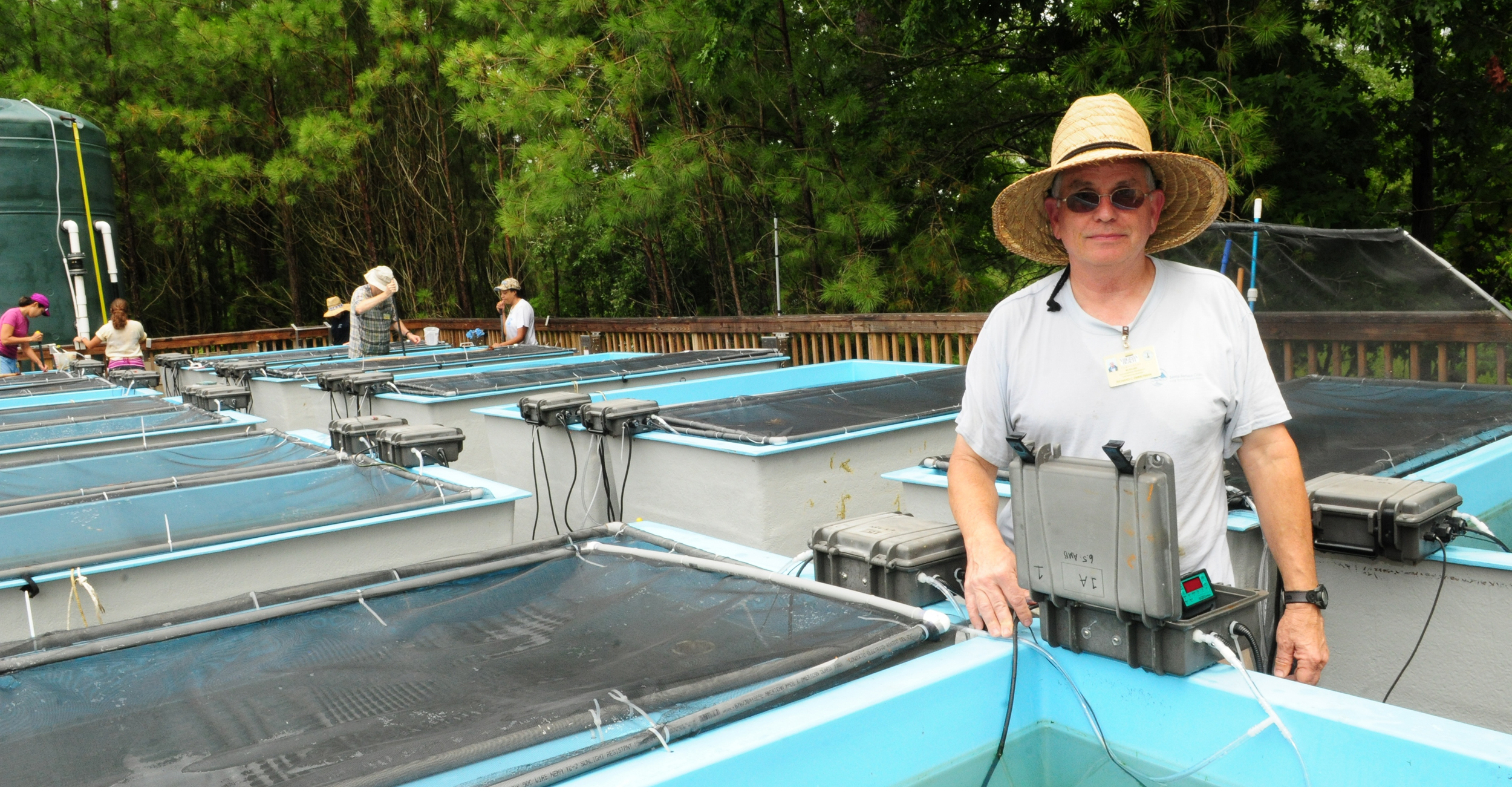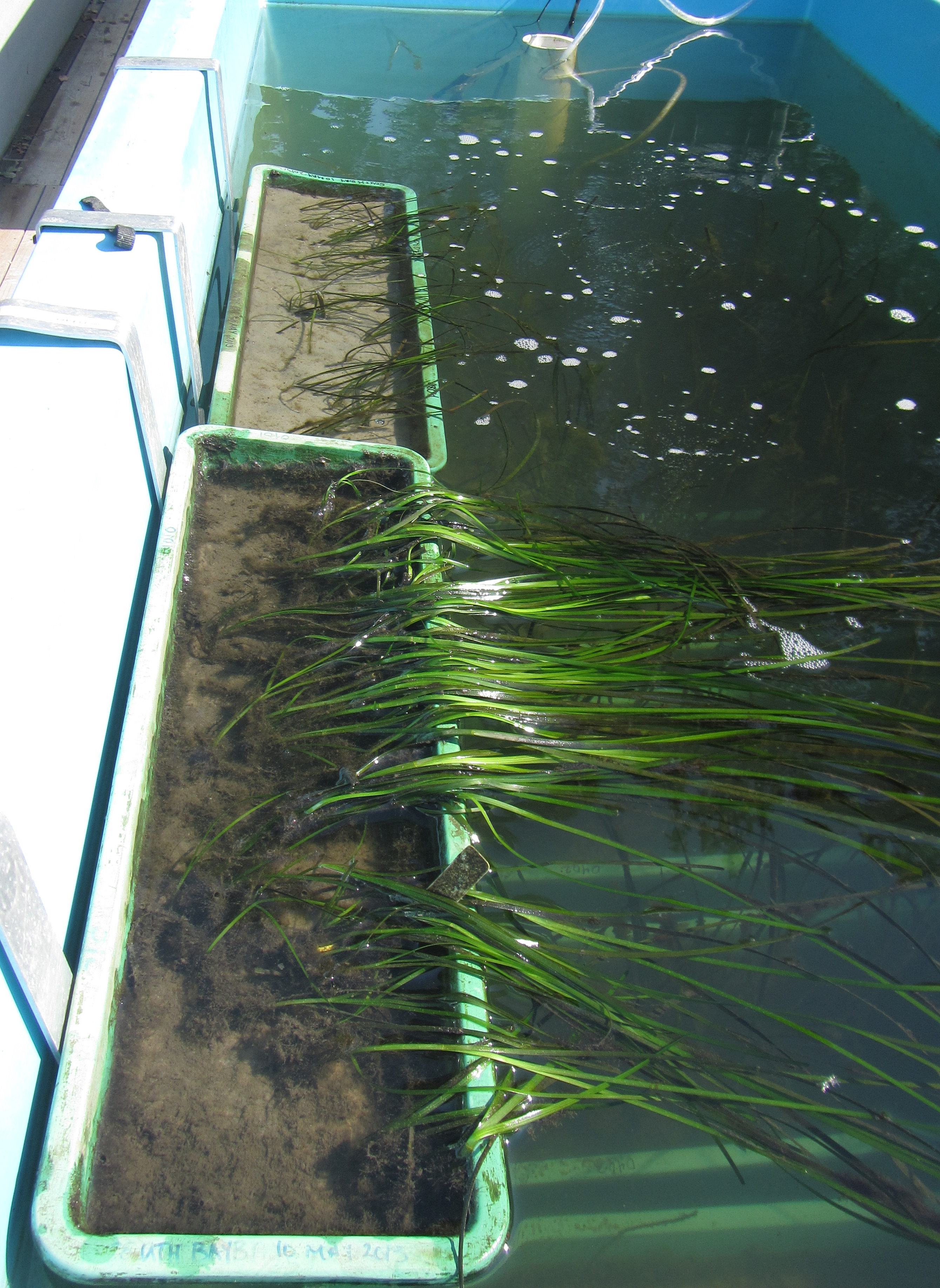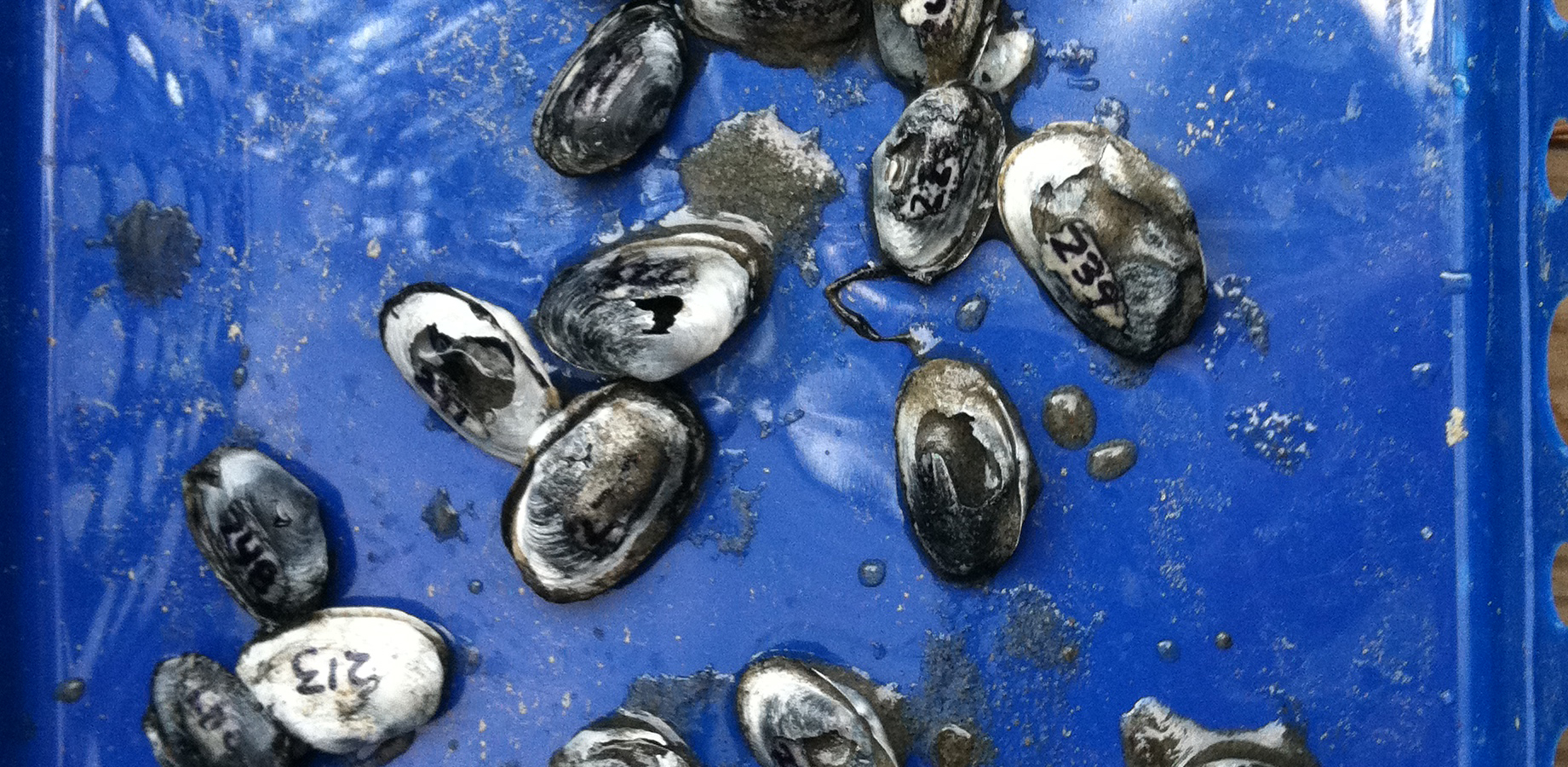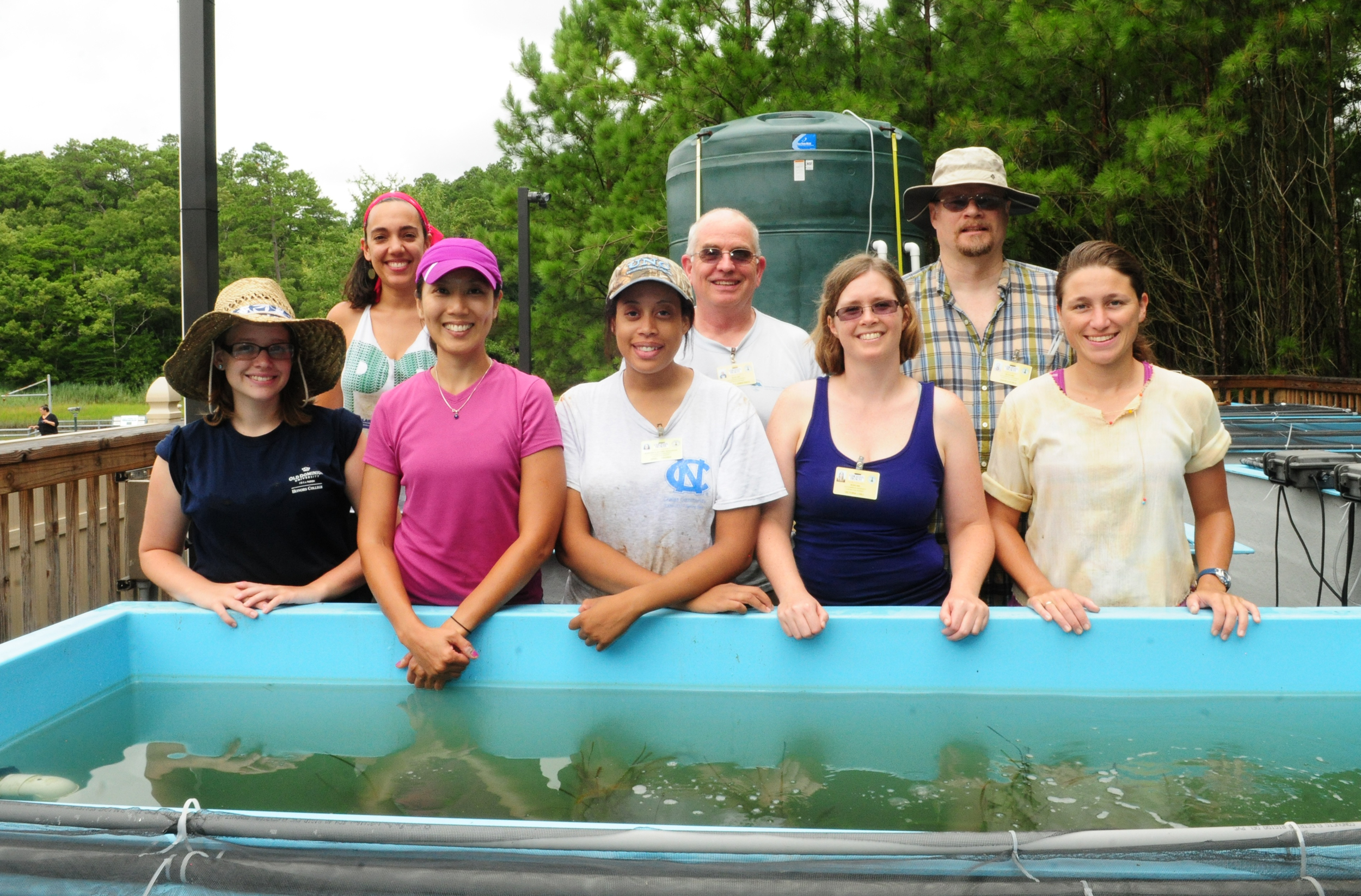Eelgrasses Win and Clams Lose in ODU-Virginia Aquarium Acidification Study
October 16, 2013
 Oceanographer Richard Zimmerman is leading the acidification studies at the aqua-farm.
Oceanographer Richard Zimmerman is leading the acidification studies at the aqua-farm.
 Eelgrasses in foreground grew in water heavily dosed with carbon dioxide. Those in far tray grew in water without subsidized carbon dioxide.
Eelgrasses in foreground grew in water heavily dosed with carbon dioxide. Those in far tray grew in water without subsidized carbon dioxide.
 Damage to shells is evident for clams that spent several weeks in acidified water.
Damage to shells is evident for clams that spent several weeks in acidified water.
 The aqua-farm research team from ODU: (front from left) research intern Miranda Smith, graduate researchers Malee Jinuntuya and Ariel Degree, Victoria Hill, graduate researcher Billur Celebi; and (rear from left) graduate researcher Carmen Zayas, Richard Zimmerman, and research associate David Ruble.
The aqua-farm research team from ODU: (front from left) research intern Miranda Smith, graduate researchers Malee Jinuntuya and Ariel Degree, Victoria Hill, graduate researcher Billur Celebi; and (rear from left) graduate researcher Carmen Zayas, Richard Zimmerman, and research associate David Ruble.
A $1 million project conducted by researchers at Old Dominion University and the Virginia Aquarium and Marine Science Center seems to be supporting its hypothesis: the steady acidification of seawater caused by increased carbon dioxide in the atmosphere will have a beneficial effect on seagrasses.
But there is more. In an interesting twist, the project has spun off another study - this one involving soft-shell clams - that shows acidification of waters could pose problems for shellfish in places such as coastal Virginia.
And still more. Another prong for the project, which also came up by chance, is studying how climate change could affect the biofilms that form on the surface of any solid material placed into water.
The way this work has unfolded, the researchers say, shows how one scientific study can lead to another in piggyback fashion.
Supported by National Science Foundation (NSF) funding, a research team led by ODU oceanographer Richard Zimmerman and including Mark Swingle, the aquarium's director of research and conservation, has built a $300,000 aqua-farm along the aquarium's Nature Trail on Owl Creek in Virginia Beach. The elaborate research facility is on a quarter-acre plot and includes 20 tubs, each large enough to hold 3,000 liters of saltwater and trays filled with sandy soil planted with eelgrasses. The temperature and pH level of the water in each tub are controlled and monitored by computers in a nearby lab trailer.
As originally planned, the project comprised tests of computer models developed by Zimmerman and another ODU oceanographer, Victoria Hill, which predicted that acidification of the seas would be a tonic, so to speak, for seagrasses.
This acidification results from the buildup in the atmosphere of carbon dioxide, much of which is from industrial and motor vehicle emissions. As Zimmerman noted, this growing acidity "is generally considered to be a bad thing." Numerous scientific studies have raised warnings that the acidification of the seas will damage corals, mollusks and other organisms that are calcareous in structure.
When carbon dioxide dissolves in water, it creates carbonic acid and the water's pH level goes down. The fact that the carbon dioxide levels in the atmosphere today are about 30 percent higher than they were in pre-industrial times means that more of the gas is available to dissolve into the seas.
"In the short term, say, 100 to 1,000 years, acidity is going to keep rising all over the globe, including the Chesapeake Bay, because atmospheric carbon dioxide will increase as long as we burn fossil fuel and deforest land," Zimmerman said. This has led scientists to predict that the jump in seawater acidity over the next century could erode calcareous corals and shells, destroying ecosystems of high environmental and economical value.
But scientists such as Zimmerman have also known that the vitality of some living things could be helped by the onslaught of greenhouse-gas buildup and global warming. "The key to this original project is that seagrasses appear to be among the few - very few - winners in an acidified ocean," he said.
Work at the Virginia Beach aqua-farm started in May and the results so far have fallen in line with the models' predictions. Higher acidity brought by pumping carbon dioxide into the tubs "seems to help eelgrasses survive in climate-warmed coastal waters affected by sediment and nutrient loading that reduces light availability," Zimmerman said. This could be a significant boon to many areas of the Chesapeake Bay where polluted, cloudy waters have pushed eelgrasses almost totally out of the picture, destroying habitat for fish and crabs and robbing the waters of oxygen that grasses give off. The grasses also absorb carbon dioxide as they grow, which could mitigate acidification threats.
By early October, eelgrasses growing in tubs filled with non-augmented water from Owl Creek (no carbon dioxide was added and pH was about 8.0) "exhibited all of the die-back characteristics of eelgrass in the Chesapeake Bay," Zimmerman said. "We lost more than half of the original shoots and survivors are scrawny."
But plants exposed to water subsidized with carbon dioxide and at a pH of about 6.5 have flourished. "Density of the grasses - or the number of shoots - is now three times what we originally planted, the leaves are much longer and wider, and they show no effect from temperature stress," Zimmerman said.
The carbon dioxide in water at pH 6.5 is about 10 times greater than what is expected this century from ocean acidification, Zimmerman explained, "but probably close to what seagrasses experienced in their early evolutionary history 50 to 100 million years ago." The researchers are looking at conditions down to pH 6.5, he said, because "our research goal goes beyond the simulation of a particular climate scenario. The experiments will help us develop predictive understanding of fundamental physiological mechanisms essential for reliable prediction of future responses, and for understanding evolutionary history. Why, for example, are these important plants carbon dioxide limited in the first place? Most marine primary producers such as phytoplankton, algae, and even corals, are not."
The eelgrass study led to a second focus with the soft-shell clams because of a serendipitous event a few weeks after the aqua-farm opened. A pipe bringing water from Owl Creek became clogged, and troubleshooters from the research team soon found the cause. Clams from the creek had gotten into the water system and were plugging up the works. After no small effort, about 50 pounds of clams were pumped out into a tub, and that's when Zimmerman had a "eureka" moment.
"We said, 'Why not see how the clams fare as we turn up the carbon dioxide and increase acidity?'" said Zimmerman, who is a professor in ODU's Department of Ocean, Earth and Atmospheric Sciences.
He recruited Lisa Horth, an associate professor of biological sciences at ODU, to lead studies of how the clams would hold up in the various tubs with different pH levels and water temperatures. A main thrust of the study is also looking into whether or not there will be genetic evidence that the clams are stressed by new environments. Rebecca Walawender, a Ph.D. student working with Horth's lab, is conducting this research.
The water in Owl Creek, where soft-shell clams grow as a native species, is currently at a pH level of about 7.5 to 8.0. But after only two months in a tub where the pH was 6.0 (and acidity increased accordingly), about 61 percent of the clams had died. "The shells of the dead clams were extremely brittle and even eroded in the center of the shell," Horth explained.
In pH 6.5, the clams were beginning to become easily breakable, although their survivorship after two months was about the same as clams kept at pH levels of 7.0, 7.5 and 8.0. The clams at pH 7.0 or higher did not exhibit brittle shells and only about 10 percent of the clams in these treatments died.
The hypothesis of Horth and Walawender is that the total number of methyl groups, which can turn genes on and off, that are bound to the genome, or genetic code, of an organism will change in relation to rising water temperatures and falling pH. In other words, global methylation will decrease, affecting normal gene expression in the clams. The research will involve comparing methylation rates of clams under various conditions in the tubs to methylation rates of clams growing naturally in Owl Creek.
"If clams can adapt to the novel environmental conditions associated with climate change, their methylation and gene expression should be similar to clams found in natural habitat," Horth explained. "We predict that clams in stressful environments will have reduced methylation rates compared to clams in non-stressful environments, and this means some of their genes are likely to be 'turned off,' or not functioning properly, in the stressful environment.
"What we do not know is whether the clams can adapt to the novel environments, and this work will help to clarify that issue. The next step would entail looking at specific genes in the genome to determine which ones are turned off or demonstrate reduced expression in the stressful environment."
The third focus for the aqua-farm presented itself when Zimmerman noted that the walls in various tubs - each with differing water temperatures and pH levels - were developing different biofilms on their surfaces. Biofilms are ubiquitous in our world and form wherever there is an interface of liquid and solid materials.
To look into his biofilms observations, Zimmerman recruited Fred Dobbs, a professor in the Department of Ocean, Earth and Atmospheric Sciences. "Everyone is familiar with biofilms," Dobbs said, "they're the reason we brush our teeth and scrub our toilet bowls. But in our case, the biofilms of interest are those that occur in coastal waters." Dobbs put his graduate student, Patrick Tennis, in charge of the investigation.
The researchers designed periphyton samplers, consisting of glass microscope slides held in floating frames in the tubs.
"As soon as the slides are deployed in a tub, organic molecules, then bacteria, then microalgae collude to cover them with biofilms," Dobbs said.
Tennis and Dobbs have found the biofilms at pH 6.0 have a vastly different composition than those at pH 7.0 or 8.0. "No scientific expertise needed to make this call," Dobbs added. "Biofilms at the low pH are dominated by diatoms (single-celled algae) and the signature species is the aptly named, wonderful to watch Carpenter's Rule Diatom. At pH 7.0 and higher, a filamentous brown alga - with a prodigious growth rate - is the dominant species."
This brown alga forms not only on the periphyton samplers (or-on microscope slides), but also coats every surface in the tubs, including the eelgrasses, Dobbs said. He and Tennis have recently extended their study to learn if the scum that is sticking to the eelgrasses has the same composition as that on microscope slides. The answer will require more time at the microscope, but in addition, they will analyze and compare the DNA of the biofilms' microbial communities.
Zimmerman said it is important to understand that biofilms are the first to colonize waters near the surface and they "set the stage" for the rest of the ecosystem. "Thus, ocean acidification effects on the biofilms can cascade throughout the ecosystem, from mud to the oysters, seagrass and fish."
All of the researchers working on the aqua-farm project say they hope the focuses on clams and biofilms can result in separate research grants, perhaps from NSF. Said Dobbs, "I hope that given its considerable investment in Dr. Zimmerman's project, NSF looks favorably at well-integrated piggyback projects that promise good scientific return."
The piggybacking may continue also for Zimmerman; he is already working on a grant application together with another ODU oceanographer, David Burdige, to explore the mitigation potential of seagrasses within the context of global warming and ocean acidification. "A big question is whether mankind can do anything to counter the increasing negative effects of ocean acidification on important resources, such as the shellfish industry," Zimmerman said. "Seagrasses may be able to play an important role, thereby acting as a shallow-water sink for atmospheric carbon dioxide."

